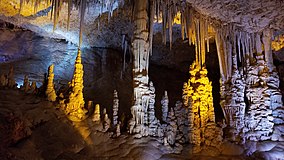Type a search term to find related articles by LIMS subject matter experts gathered from the most trusted and dynamic collaboration tools in the laboratory informatics industry.
| Avshalom Nature Reserve | |
|---|---|
| Soreq/Sorek Cave, Avshalom Cave, Stalactites Cave | |
 | |
| Location | On the western slopes of the Judean Hills, south of Nahal Soreq and approximately 2 kilometers east of Bet Shemesh. |
| Nearest city | Bet Shemesh |
| Governing body | Israel Nature and Parks Authority |
Avshalom Cave (Hebrew: מערת אבשלום, romanized: Me'arat Avshalom), known in academic literature as Soreq Cave (Hebrew: מערת שׂורק, romanized: Me'arat Soreq; Arabic: مغارة سوريك, romanized: Mghar Suriq) and popularly as Stalactites Cave (Hebrew: מערת הנטיפים, romanized: Me'arat HaNetifim), is a 5,000 m2 cave on the western side of Mt. Ye'ela, in the Judean hills in Israel, unique for its dense concentration of stalactites and other cave formations. It is a popular show cave, as well as a highly valued witness of the climate evolution over the last 185,000 years.
The cave is named after the Soreq/Sorek Valley (Nahal Sorek) and after Avshalom Shoham, an Israeli soldier killed in the War of Attrition.
Avshalom Cave is situated near Hartuv, 3 km east of Bet Shemesh, Israel.
The cave was discovered accidentally in May 1968, while quarrying with explosives.
After its discovery, the location of the cave was kept a secret for several years for fear of damage to its natural treasures.
The cave is 83 m long, 60 m wide, and 15 m high.
The temperature and the humidity in the cave are constant year round.[1]
Some of the stalactites found in the cave are four meters long, and some have been dated as 300,000 years old. Some meet stalagmites to form stone pillars.[2]
The cave has been the focus of paleoclimate research, which allowed reconstruction of the region's semi-arid climate for the past 185,000 years.[3] According to the American geologist James Aronson, the Soreq Cave is the Rosetta Stone of climate history in the Eastern Mediterranean.[4]
The cave is now open to visitors, in the heart of the 67-dunam Avshalom Nature Reserve, declared in 1975.[1] In 2012, a new lighting system was installed to prevent the formation and growth of algae.[5]